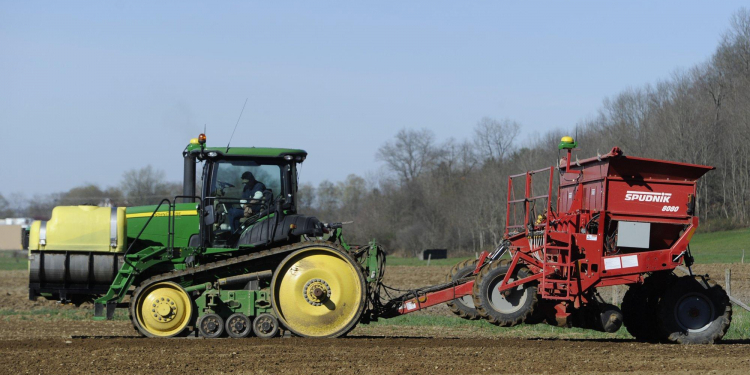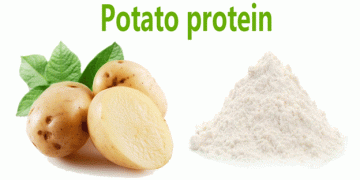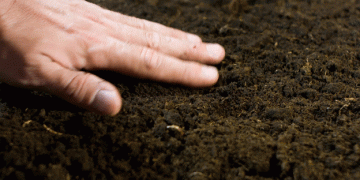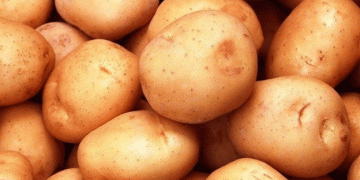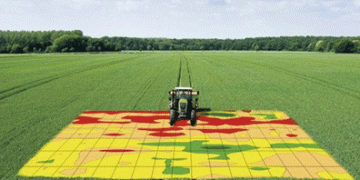Both yield and quality were comparable in an initial trial comparison of traditional spring tillage and direct seeding

The amount and quality of the potatoes coming off Chad Berry’s field last fall weren’t that much different from one side to the other, but one half came with a lot less tillage. Results are in from the 2020 field-scale trial, which hoped to create a side-by-side comparison of conventional spring tillage and direct seeded potatoes.
Why it matters: Initial data out of an attempt to scale up reduced-tillage potato production looks good on yield and quality, which might open the door for other producers to look at the practice.

It was Berry’s second effort on reduced-tillage potato management following a 2019 test planting into fall rye stubble. Berry, of Under the Hill Farms near Glenboro, hoped the practice would reduce wind erosion and hill damage.
Like many potato acres in Manitoba in 2019, however, those first acres went unharvested due to weather. This year, Berry tried again. The demonstration trial, in co-operation with Simplot Canada, direct seeded half of Berry’s field into canola stubble, while three soil probes were installed on each side of the field to measure soil compaction and moisture, among other metrics.
“It definitely helped with soil erosion,” Berry said. “It prevented any blowing.” Both sides of the field were still deep ripped the previous fall, but the field section allocated to direct seeding saw only one pass in spring 2020.
Berry’s planters had already been upgraded to a one-pass planting, hilling and fertilizer system, featuring hillers inspired by technology Berry and local equipment company genAg had seen at Germany’s Agritechnica trade show. Berry and genAg then worked to adapt the hillers for a North American machine, resulting in Berry’s current 34-inch, eight-row Spudnik planters.
The result, Berry said, was two fewer tillage passes prior to planting on the direct-seeded side. Fuel savings came in at about 2.5 gallons of diesel saved for every dodged tillage pass.

“When you calculate the carbon footprint using the U.S. EPA, that’s an estimated 0.051 tonne of CO2 per acre,” Scott Graham, agronomy raw development manager with Simplot Canada, said.
Both Graham and Vikram Bisht, a provincial agronomist called in as technical adviser for the project, flagged the 2020 results as positive. There was no significant penalty in either yield or quality from direct planting, they found. Tuber gravity, disease and quality issues like hollow heart or sunburn, likewise, all showed no statistical difference between the two planting systems.
Bisht noted the neutral impact on yield and quality for other producers looking to address erosion concerns, while also pointing to potential savings in fuel and equipment wear. Direct-seeded hills also had more trash cover, according to results, something Bisht says likely reduced disturbance on those hills.
Direct seeded hills were slightly larger at the end of the season near harvest, the results noted. The trial was a good first step in the right direction to reduce soil erosion while maintaining and increasing soil productivity and reducing production costs for farmers,” Graham said.
Emergence delay

There was, however, a three- to four-day delay in emergence for direct-seeded potatoes, although that did not translate into a delay in harvest timing. Berry said he was pleased with the trial, although there’s likely still ways to hone management for better results.
The emergence delay, for example, he said, likely had much to do with their early-season management, although Bisht suggested the delay might also be linked to cooler temperatures with direct seeding compared to black cultivated soil. Stubble in the hill likely impacted seed-to-soil contact, Berry suggested, and direct-seeded seed pieces also likely suffered from a lack of moisture as the one-pass system covered them with dry dirt. Next time, he said, the farm would likely water the crop right after planting.
“It’s a change and it’s going to take awhile to get everything figured out, how to operate properly, but for the first full-size field we did this year, we were happy with it,” he said.
Questions for spring
More data needs to be collected, and in more places, on the changed hill size and impact on greening or uncovered seed, Bisht added. Bisht also cautioned against drawing too many conclusions from a single year’s data. “But what we got was pleasing enough to repeat the trial,” he said. That repeat trial would likely involve more pre-planting discussions between the different parties to outline trial parameters and look for improvements, he said. The trial would also look to understand how inherent soil characteristics might be playing into the data.
Earlier this year, Berry stressed the importance of field selection when looking at direct seeding. A field with heavier soil might be setting the producer up for a fight with soil lumps, he said, while fine sandier soil might be better suited. Bisht also stressed the importance of selecting a field that is uniform on both sides for any upcoming trial repeat. Simplot Canada plans to repeat the trial in 2021, with the same producer, Graham said.
“There are other producers who are watching closely and there is some interest in the trial, in direct seed farming,” he said.
